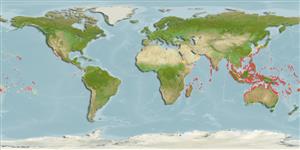Holothuroidea |
Synallactida |
Stichopodidae
Environment: milieu / climate zone / depth range / distribution range
Ecology
Reef-associated; depth range 0 - 25 m (Ref. 122). Tropical
Indo-Pacific.
Length at first maturity / Size / Weight / Age
Maturity: Lm ?, range 27 - ? cm Max length : 90.0 cm TL male/unsexed; (Ref. 118); common length : 35.0 cm TL male/unsexed; (Ref. 122); max. published weight: 2.5 kg (Ref. 122)
Mean live weight 200 to 2500 g; body-wall thickness 0.2-0.8 cm. Body firm, rigid, square-ish in cross-section, flattened ventrally (trivium); body wall easily disintegrates outside sea water. Bivium covered with irregular warts, arranged in 8-10 longitudinal rows, with smaller papillae in between; warts larger near mouth. Trivium with yellow to pink podia delimited by a characteristic double row of large papillae 4 to 5 mm; stout podia arranged in 4 rows, on 3 radial bands, their disc about 380 micrometer in diameter. Mouth ventral, surrounded by a half row of papillae and 18 brown, short tentacles. Anus terminal. Calcareous ring with deeply indented radial pieces and triangular interradials. Cuvierian tubules absent. Bivium whitish to grey, with brown irregular dots; trivium lighter. Spicules with very characteristic rosettes, X-shaped, or elongate, numerous in the tegument; presence of numerous C-shaped spicules of 3 sizes; ventral tegument with tables of 2 sizes; some tables have a circular disc with 4 central and about 15 peripheral holes, bearing a spire with 4 pillars ending in a moderately spiny and cross-shaped crown; tables with a larger disc also present, more perforated, with a higher, spiny crown; only the first kind table found in the dorsal tegument; tables in papillae provided with a very large multiperforated disc, with a long, conical, smooth spire, ending in a single point; ventral papillae containing long, smooth rods; ventral podia have long rods, with central apophasis, and large elongate, multiperforated plates; tentacles with large rods, narrow, either curved with few spines, or straight and very spiny; X-, S-, and C-shaped small spicules.
Probably not harvested, as the tegument disintegrates too quickly. An aquaculture programme for this species is presently being carried out for stock enhancement purposes. A reef species mostly found in shallow areas in coastal reef and lagoons from near the surface to a depth of 25 m; generally occurs in seagrass beds, rubbles or hidden in reef flats or dead corals (Ref. 800), and muddy-sand bottoms (Ref. 122); on algal beds and on clean sandy bottoms. A pea crab is known to live in the cloacal chamber (Ref. 118). A nocturnal species. Populations not reaching high densities, with mean of around 0.007 per square meter. Biology poorly known (Ref. 122).
Sexual reproduction takes place during warm season. A species with a low potential fecundity and late sexual maturity (Ref. 122). Members of the class Holothuroidea are gonochoric and have only one gonad. Spawning and fertilization are both external and some exhibit brooding. Life cycle: Embryos develop into planktotrophic larvae (auricularia) then into doliolaria (barrel-shaped stage) which later metamorphose into juvenile sea cucumbers (Ref. 833).
Conand, C. 1998 Holothurians (sea cucumbers, Class Holothuroidea). p. 1157-1190. In Carpenter, K.E. and V.H. Niem (eds.) FAO Species Identification Guide for Fishery Purposes. The Living Marine Resources of the Western Central Pacific. Vol. 2. Cephalopods, crustaceans, holothurians and sharks. FAO Rome. (Ref. 122)
IUCN Red List Status
(Ref. 130435: Version 2025-1)
CITES status (Ref. 108899)
Not Evaluated
Not Evaluated
Threat to humans
Harmless
Human uses
Fisheries: commercial
| FishSource | Sea Around Us
Tools
More information
Trophic EcologyFood items (preys)
Diet composition
Food consumption
Predators
PhysiologyOxygen consumption
Human RelatedStamps, coins, misc.
Internet sources
Estimates based on models
Preferred temperature
(Ref.
115969): 24.7 - 29.3, mean 28.4 (based on 3265 cells).
Fishing Vulnerability
High to very high vulnerability (72 of 100).
Price category
Unknown.
Nutrients : Calcium = 126 [75, 177] mg/100g; Iron = 4.79 [1.67, 7.92] mg/100g; Protein = 16.6 [15.4, 17.8] %; Omega3 = 0.331 [0.263, 0.400] g/100g; Selenium = 57.8 [48.5, 67.2] μg/100g; VitaminA = 0 μg/100g; Zinc = 1.97 [0.92, 3.02] mg/100g (wet weight); based on
nutrient studies.
